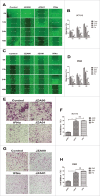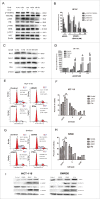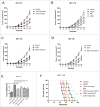Anti-VEGFR2-interferon-α2 regulates the tumor microenvironment and exhibits potent antitumor efficacy against colorectal cancer
- PMID: 28405526
- PMCID: PMC5384376
- DOI: 10.1080/2162402X.2017.1290038
Anti-VEGFR2-interferon-α2 regulates the tumor microenvironment and exhibits potent antitumor efficacy against colorectal cancer
Abstract
Interferon-α (IFNα) has multiple antitumor effects including direct antitumor toxicity and the ability to potently stimulate both innate and adaptive immunity. However, its clinical applications in the treatment of malignancies have been limited because of short half-life and serious adverse reactions when attempting to deliver therapeutically effective doses. To address these issues, we fused IFNα2a to the anti-vascular endothelial growth factor and receptor 2 (VEGFR2) antibody JZA00 with the goal of targeting it to the tumor microenvironment where it can stimulate the antitumor immune response. The fusion protein, JZA01, is effective against colorectal cancer by inhibiting angiogenesis, exhibiting direct cytotoxicity, and activating the antitumor immune response. Although JZA01 exhibited reduced IFNα2 activity in vitro compared with native IFNα2, VEGFR2 targeting permitted efficient antiproliferative, proapoptotic, antiangiogenesis, and immune-stimulating effects against the colorectal tumors HCT-116 and SW620. JZA01 showed in vivo efficacy in NOD-SCID mice-bearing established HCT-116 tumors. In conclusion, this study describes an antitumor immunotherapy that is highly promising for the treatment of colorectal cancer.
Keywords: CD8+ T cells; DCs; IFNα2; VEGFR2; colorectal cancer; tumor microenvironment.
Figures









Similar articles
-
VEGFR2-targeted antibody fused with IFN α mut regulates the tumor microenvironment of colorectal cancer and exhibits potent anti-tumor and anti-metastasis activity.Acta Pharm Sin B. 2021 Feb;11(2):420-433. doi: 10.1016/j.apsb.2020.09.008. Epub 2020 Sep 19. Acta Pharm Sin B. 2021. PMID: 33643821 Free PMC article.
-
YM-359445, an orally bioavailable vascular endothelial growth factor receptor-2 tyrosine kinase inhibitor, has highly potent antitumor activity against established tumors.Clin Cancer Res. 2006 Mar 1;12(5):1630-8. doi: 10.1158/1078-0432.CCR-05-2028. Clin Cancer Res. 2006. PMID: 16533791
-
PBA2 exhibits potent anti-tumor activity via suppression of VEGFR2 mediated-cell proliferation and angiogenesis.Biochem Pharmacol. 2018 Apr;150:131-140. doi: 10.1016/j.bcp.2018.01.051. Epub 2018 Feb 3. Biochem Pharmacol. 2018. PMID: 29408327
-
Melittin-MIL-2 fusion protein as a candidate for cancer immunotherapy.J Transl Med. 2016 Jun 1;14(1):155. doi: 10.1186/s12967-016-0910-0. J Transl Med. 2016. PMID: 27246873 Free PMC article.
-
Alpha-Galactosylceramide/CD1d-Antibody Fusion Proteins Redirect Invariant Natural Killer T Cell Immunity to Solid Tumors and Promote Prolonged Therapeutic Responses.Front Immunol. 2017 Nov 1;8:1417. doi: 10.3389/fimmu.2017.01417. eCollection 2017. Front Immunol. 2017. PMID: 29163493 Free PMC article. Review.
Cited by
-
Interferon-γ and Colorectal Cancer: an up-to date.J Cancer. 2018 Jan 1;9(2):232-238. doi: 10.7150/jca.22962. eCollection 2018. J Cancer. 2018. PMID: 29344268 Free PMC article. Review.
-
How the Tumor Micromilieu Modulates the Recruitment and Activation of Colorectal Cancer-Infiltrating Lymphocytes.Biomedicines. 2022 Nov 15;10(11):2940. doi: 10.3390/biomedicines10112940. Biomedicines. 2022. PMID: 36428508 Free PMC article. Review.
-
Next-generation cytokines for cancer immunotherapy.Antib Ther. 2021 Jun 25;4(2):123-133. doi: 10.1093/abt/tbab014. eCollection 2021 Apr. Antib Ther. 2021. PMID: 34263141 Free PMC article. Review.
-
Targeting inflammation as cancer therapy.J Hematol Oncol. 2024 Mar 22;17(1):13. doi: 10.1186/s13045-024-01528-7. J Hematol Oncol. 2024. PMID: 38520006 Free PMC article. Review.
-
Continuous sensing of IFNα by hepatic endothelial cells shapes a vascular antimetastatic barrier.Elife. 2022 Oct 25;11:e80690. doi: 10.7554/eLife.80690. Elife. 2022. PMID: 36281643 Free PMC article.
References
-
- Spill F, Reynolds DS, Kamm RD, Zaman MH. Impact of the physical microenvironment on tumor progression and metastasis. Curr Opin Biotechnol 2016; 40:41-8; PMID:26938687; http://dx.doi.org/ 10.1016/j.copbio.2016.02.007 - DOI - PMC - PubMed
-
- Joyce JA, Fearon DT. T cell exclusion, immune privilege, and the tumor microenvironment. Science 2015; 348(6230):74-80; PMID:25838376; http://dx.doi.org/ 10.1126/science.aaa6204 - DOI - PubMed
-
- Pittet MJ. Behavior of immune players in the tumor microenvironment. Curr Opin Oncol 2009; 21(1):53-9; PMID:19125019; http://dx.doi.org/ 10.1097/CCO.0b013e32831bc38a - DOI - PMC - PubMed
-
- Buchbinder EI, McDermott DF. Interferon, interleukin-2, and other cytokines. Hematol Oncol Clin North Am 2014; 28(3):571-83; PMID:24880948; http://dx.doi.org/ 10.1016/j.hoc.2014.02.001 - DOI - PubMed
-
- Borden EC, Sen GC, Uze G, Silverman RH, Ransohoff RM, Foster GR, Stark GR. Interferons at age 50: past, current and future impact on biomedicine. Nat Rev Drug Discov 2007; 6(12):975-90; PMID:18049472; http://dx.doi.org/ 10.1038/nrd2422 - DOI - PMC - PubMed
Publication types
LinkOut - more resources
Full Text Sources
Other Literature Sources
Research Materials
